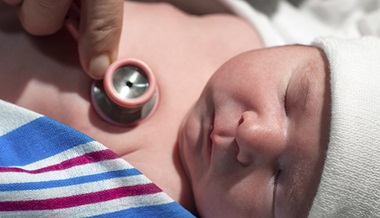Congenital Heart Defects (CHD)
What is a congenital heart defect (CHD)?
A congenital heart defect (CHD) occurs when the heart or the blood vessels near the heart don’t develop normally before birth.
CHDs occur in about 1 out of 100 babies. Due to advances in early diagnoses, testing, treatment and surgeries, most young people with these conditions are living into adulthood.
Most heart defects cause abnormal blood flow through the heart, a lack of formation or a fault in one of the pumping chambers, or blocked blood flow in the heart or vessels. (A blockage is called stenosis, and can occur in heart valves, arteries or veins.) A hole between two chambers of the heart is an example of a very common type of congenital heart defect.
Less common defects include those in which:
- The right or left side of the heart is not fully formed (hypoplastic).
- There is only one ventricle.
- Both the pulmonary artery and aorta start from the same ventricle.
- The pulmonary artery and aorta start from the wrong ventricles.
Causes and Risk Factors of Congenital Heart Defect
In most cases, the cause of a congenital heart defect is unknown. The condition can be passed on through the parents’ genes (genetic or hereditary). A small percentage of congenital heart defects are related to chromosomal abnormalities.
Risk factors occurring during pregnancy may also increase the chance for development of a CHD. It’s best to consult your physician about the following factors:
- Having type 1 or type 2 diabetes
- Taking certain medications
- Drinking alcohol
- Smoking
Congenital Heart Defect Symptoms
For many babies, a congenital heart defect is detected and diagnosed before birth through a fetal echocardiogram.
When a heart defect is detected after birth, a baby may show symptoms such as:
- Difficulty breathing
- Low oxygen levels
- Blueish color of the skin, lips or nails (“cyanosis”)
- Poor feeding and weight gain
- Abnormal heart rate or rhythm
- Abnormal sound of the heart (heart murmur)
In older children, symptoms may also include:
- Shortness of breath
- Chest pain with exertion
- Poor weight gain
- Syncope or fainting
How are congenital heart defects diagnosed?
Congenital heart defects are often diagnosed before birth through a fetal echocardiogram. This is a type of ultrasound that is used to take pictures of an unborn baby’s heart and examine the heart’s structure, function and rhythm.
Some heart defects may not be detected until after birth. Doctors may observe symptoms of a heart defect, such as a murmur or cyanosis, immediately after birth. Some children with simple defects may not show symptoms or be diagnosed until they are older.
Depending on your child’s age and symptoms, the pediatric cardiologist may order certain tests to diagnose a congenital heart defect or obtain more information about your child’s condition. These tests can include:
- Echocardiogram (ultrasound of the heart)
- Electrocardiogram
- Cardiac MRI
- Cardiac CT scan
- Cardiac catheterization
- Exercise stress test
- Blood test for genetic analysis
Types of congenital heart defects
There are many heart disorders that need clinical care from a health care professional. Listed below are some of these conditions:
Obstructive defects
- Aortic stenosis: The aortic valve between the left ventricle and the aorta did not form properly and is narrowed, making it difficult for the heart to pump blood to the body.
- Pulmonary stenosis: The pulmonary valve does not open properly, causing the heart to pump harder than normal to overcome the obstruction.
- Bicuspid aortic valve: An infant is born with a bicuspid valve, which has only two flaps (called leaflets) instead of three, which is considered normal.
- Subaortic stenosis: The left ventricle narrows just below the aortic valve, often resulting in an increased workload for the left ventricle. Subaortic stenosis may be congenital or caused by a form of cardiomyopathy (disease of the heart muscle).
- Coarctation of the aorta: The aorta is narrowed or constricted, obstructing blood flow to the lower part of the body and increasing blood pressure above the constriction.
- Double outlet right ventricle: The aorta and the pulmonary artery are both connected to the right ventricle, and no arteries are attached to the left ventricle, affecting blood flow.
- Pulmonary atresia: The pulmonary valve (which is found between the right ventricle and the pulmonary artery) does not develop correctly, which prevents blood flow from the right side of the heart into the lungs.
- Truncus arteriosus: Truncus arteriosus results when only one vessel leaves the heart and supplies blood to the lungs and body. This happens when the aorta and pulmonary artery do not separate.
- Complex single ventricle: The heart develops abnormally so that it has one large ventricle instead of two, meaning the patient only has one working ventricle. This may cause either too much or too little blood flow to the lungs.
Septal defects
Some congenital heart defects allow blood to flow between the right and left chambers of the heart because an infant is born with an opening in the wall (or septum) that separates the right and left sides of the heart.
- Atrial septal defect: An opening between the two upper chambers of the heart — the right and left atria — causes an abnormal blood flow through the heart.
- Ventricular septal defect: A hole present between the two lower chambers of the heart causes blood from the left ventricle to flow into the right ventricle. This causes extra blood to be pumped into the lungs.
- Atrioventricular canal (AVC or AV canal) or atrioventricular septal defect (AVSD): In this condition, the heart has several structural abnormalities, including atrial septal defect, ventricular septal defect, and improperly formed mitral and/or tricuspid valves. Blood mixes freely throughout the four chambers of the heart, causing issues in both the heart and lungs, which results in poor weight gain, breathing problems and cyanosis (turning blue).
Cyanotic defects
Cyanotic defects are defects in which blood pumped to the body contains less-than-normal amounts of oxygen. It causes a blue discoloration of the skin. Infants with cyanosis are often called “blue babies.”
- Tetralogy of Fallot: The most common defect causing cyanosis in people beyond 2 years of age. Most children with tetralogy of Fallot have open-heart surgery before school age (frequently in infancy) to close the ventricular septal defect and remove the obstructing muscle. Lifelong medical follow-up is needed.
- Tricuspid atresia: In this condition, there is no tricuspid valve; therefore, no blood flows from the right atrium to the right ventricle.
- Transposition of the great arteries: In this embryologic defect, the positions of the pulmonary artery and the aorta are reversed.
- Anomalous pulmonary venous return: The heart typically has four pulmonary veins that bring oxygen-rich blood back from the lungs to the left atrium (upper left chamber of the heart). In this defect, one or more of the pulmonary veins returns to the right side of the heart instead of the left.
Other defects
- Hypoplastic left heart syndrome: The left side of the heart, including the aorta, aortic valve, left ventricle and mitral valve, is underdeveloped.
- Patent ductus arteriosus: A condition resulting from the failure of the opening between the aorta and the pulmonary artery to close normally after birth, allowing blood to mix between the pulmonary artery and the aorta.
- Anomalous left coronary artery: This defect occurs when the left coronary artery (which supplies blood to the left side of the heart) is connected to the pulmonary artery instead of the aorta, which restricts the flow of oxygen-rich blood into the heart.
- Ebstein’s anomaly: In this defect, there is a downward displacement of the tricuspid valve (located between the upper and lower chambers on the right side of the heart) into the right bottom chamber of the heart (or right ventricle). This means the atrium is larger than normal and the ventricle is smaller than normal, which can lead to rhythm abnormalities and heart failure. It is usually associated with an atrial septal defect.
- Corrected transposition of the great arteries: Both the ventricles and the arteries are reversed. Typically, the left ventricle pumps blood to the body, and the right ventricle pumps blood to the lungs. Because of this, the left ventricle is stronger than the right. In corrected transposition of the great arteries, because the ventricles are reversed, the weaker ventricle is tasked with pumping blood to the entire body. Some patients with this defect will have no or few symptoms as children, and may not require immediate treatment. Some may need surgery; the type of surgery depends on the individual patient’s condition and any other associated heart defects they may have.
- Mitral valve prolapse: A condition that occurs when the flaps of the mitral valve do not form normally and allow blood to leak backward into the left atrium.
Who treats congenital heart defects?
For Babies and Children
Babies with congenital heart problems are followed by specialists called pediatric cardiologists. These doctors diagnose heart defects and help manage the health of children before and after surgical repair of the heart problem. Specialists who correct heart problems in the operating room are known as pediatric cardiovascular or cardiothoracic surgeons.
Treatment depends on the child’s individual condition. Some simple defects may just need to be monitored. Some conditions may be treated using medications. Cardiac catheterization is also used to treat some heart defects.
Other conditions will require surgery — in some cases, within the first weeks or months of life. Complex conditions, such as single ventricle defects, will require multiple surgeries to repair the defect.
Your child’s pediatric cardiologist will work with you and your family to explain your child’s condition, and the treatment and follow-up care he or she will need.
For Adults
To achieve and keep the highest possible level of wellness, it’s vital that people born with CHD who have reached adulthood transition to the appropriate type of cardiac care. The type of care needed is based on the type of CHD a person has. People with simple CHD can often be cared for by a community adult cardiologist. People with more complex types of CHD will need to be cared for by a cardiologist with expertise in CHD.
Adults with CHD need guidance to plan for key life concerns, such as:
- College and career
- Insurance
- Activity and lifestyle
- Inheritance
- Family planning and pregnancy
- Chronic care
- Disability
- End of life
Transitioning from pediatric care to adult care
The transition to adult care can start in your child’s early teen years. It should be personalized for your child. Early on, you and the specialist should talk with your young teen about the idea that they will one day be responsible for their own care. This will depend on several factors, such as your child’s ability to care for themselves. It’s best started when your child is fairly healthy. Your child will need to be able to:
- Talk in some detail about their condition
- Take their medicine
- Tell if their condition is changing or getting worse
A successful transition to adult care will review:
- Knowledge about their specific congenital heart defect and surgical history
- Expectations for long-term outcomes and possible complications
- Potential risks
- Ways to empower young adults to live healthy lifestyles
Talk with the pediatric cardiologist about how to ensure a smooth transition from pediatric to adult care for your child. Other considerations, include:
- Ask your child’s health care team (both specialist and primary care provider) when they typically transition young people to adult clinics.
- Ask the health care team for advice about finding qualified health care providers.
- Plan for changes in insurance.
- Understand the psychological challenges that can occur with teens when transitioning to an adult practice. These include nervousness, excitement, hope and frustration.
- If possible, make sure your teen has someone other than a family member to discuss impacts of their disease on dating and other social relationships.
- Work with your child’s pediatric clinic to make a list of goals for transition. Check in on these goals at each routine visit.
Talk with your child early and often about their role as a patient. Having your child take a greater role in their own health care over time is a big responsibility. Give your child positive reinforcement when they show independence in their own health care.






